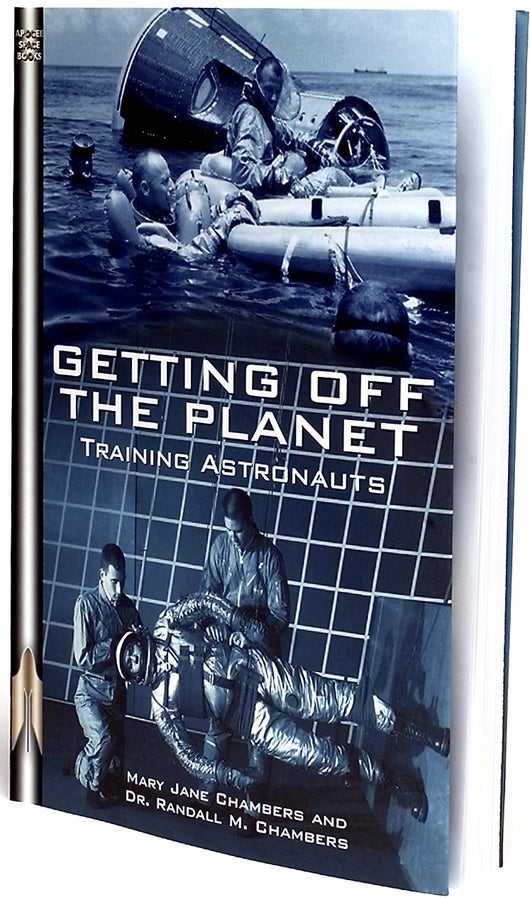Mary Jane Chambers and Randall M. Chambers, 120 pages, CG Publishing, Apogee Books Space Series, 2006; paperback, $18.95
Apogee Books has done a great service for a new generation of readers by preserving and making accessible much of the history of spaceflight, in its Space Science book series. Each book in the Apollo Mission Report details one specific flight. While many books have been written by and about astronauts, less well-known are the stories of the manned space program’s unsung heroes: those scientists and engineers, such as Harrison Storms and Guenter Wendt, whose skills, dedication, and purpose made it possible for the United States to progress from Alan Shepard’s Mercury suborbital flight to a successful lunar landing and return in just over 8 years.
How to train astronauts was an open question in the early space program. Getting off the Planet is a book about this aspect of spacefight. Written primarily by Mary J. Chambers, this book describes the efforts of her husband, Dr. Randall Chambers — a psychologist experienced in human-factors engineering and performance. The story relates much of Dr. Chambers’ work in designing spacecraft from a human-factors perspective and for training astronauts. A few related engineering efforts involved designing a spacesuit to provide protection and biomedical monitoring, and engineering a spacecraft cabin environment to control temperature, pressure, and noise. Dealing with confinement and isolation, personal hygiene, sleep cycles, eating, and waste disposal were important to the experiments.
Many of the experiments and training described in this book involve the human centrifuge at the Naval Air Development Center in Pennsylvania. For example, scientists had to determine how to place an astronaut in a spacecraft to not only withstand high acceleration through launch and re-entry, but also how to design a craft so the astronaut could work safely and operate controls during periods of vibration and disorienting motions. While researching astronauts’ (and some animals’) endurance limits, Dr. Chambers required that he serve as the first test subject.
| Mauna Kea: A Guide to Hawai’i’s Sacred Mountain |
| Leslie Lang and David A. Byrne, 152 pages, Watermark Publishing, 2005; paperback, $17.95 |
 If you’re considering a trip to Mauna Kea in the future, this is a good book to pick up. Leslie Lang and David Byrne include information about the astronomy atop Mauna Kea in this guidebook’s largest section, but they also delve into its ancient history and the mountain’s geology. And if you have an opportunity to visit the Sacred Mountain, Lang and Byrne overview various recreational activities (hiking, anyone?) and the visitor center. — Liz Kruesi If you’re considering a trip to Mauna Kea in the future, this is a good book to pick up. Leslie Lang and David Byrne include information about the astronomy atop Mauna Kea in this guidebook’s largest section, but they also delve into its ancient history and the mountain’s geology. And if you have an opportunity to visit the Sacred Mountain, Lang and Byrne overview various recreational activities (hiking, anyone?) and the visitor center. — Liz Kruesi |
The authors also discuss extensive microgravity simulations and training in water tanks and in the “vomit comet,” a KC-135 aircraft, which flies parabolic arcs to create half-minute periods of weightlessness. One aspect of astronaut training that could have been improved, which the authors mention, was how astronauts and scientists coped with the demands of public appearances after gaining celebrity status.
Getting off the Planet relates some of Dr. Chambers’ work, but it often leaves the reader wanting to know more, such as how data from the scientific experiments were used to design training programs. Perhaps another book should be written to tell about other aspects of the early training program, like flight simulators, jungle survival training, geological training for the Moon missions, and celestial navigation. Sometimes the writing style is folksy, repetitious (we’re told of a meeting between Dr. Chambers and Neil Armstrong on page 88 and again on page 95) and sometimes trite (we’re referred to as “earthlings” and space as “mysterious”).
Maybe it would have been best if the author had avoided trying to explain concepts if she was unsure of their meanings, such as velocities and accelerations on page 52. Omission is preferable to erroneous explanations.
Even with these concerns, at 120 pages, this book is an easy and enjoyable read that would appeal to those interested in activities essential to space exploration. An especially enjoyable feature of the book is the unique variety of photographs of training facilities and astronauts in training.
— Robert D. Miller has been involved with astronomy research, teaching, and writing for 30 years. He has written a number of papers and coauthored the book Making and Enjoying Telescopes.










